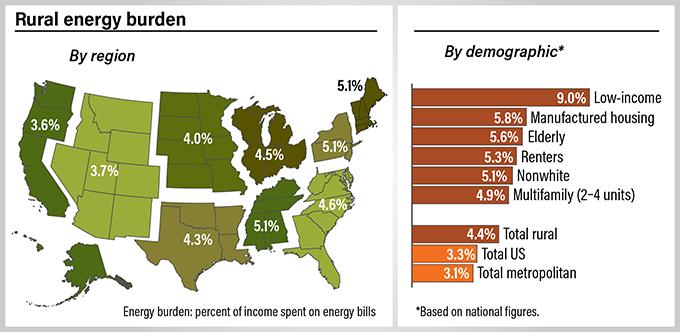Washington, DC…Rural households across the United States spend a disproportionately high share of their income on energy bills — about 40% more than their metropolitan counterparts, according to a new report released today by the American Council for an Energy-Efficient Economy (ACEEE) and the Energy Efficiency for All (EEFA) coalition. The problem is most glaring in the East and Southeast, and among low-income households across all regions.
Overall, rural households have a median energy burden — the percentage of a household’s income spent on home energy bills for needs such as air conditioning, heating, lighting, appliances, and cooking — of 4.4%, which is one-third higher than the national burden. Those with low incomes have a median energy burden of 9%, which is almost three times that of higher-income counterparts. In several rural regions, this burden exceeds 15% for one of every four low-income households. In addition to income level, other factors may increase energy burdens, including a home’s physical condition, a household’s ability to invest in energy-efficient equipment and upgrades, and the availability of efficiency programs and incentives that put energy-saving technologies within reach.
Other rural residents hit particularly hard include elderly, nonwhite, and renting households, as well as those living in multifamily and manufactured homes. The East South Central, New England, and Mid-Atlantic regions have the highest median rural energy burdens, at 5.1%
But with the right policies and initiatives, those with high energy burdens could see some relief. Energy efficiency upgrades can lessen these energy burdens by as much as 25%, resulting in more than $400 in annual energy bill savings for some households.
The report, The High Cost of Energy in Rural America: Household Energy Burdens and Opportunities for Energy Efficiency, is the first to focus on the energy burdens shouldered by those living in rural America. It builds on a previous report, Lifting the High Energy Burdens in America’s Largest Cities: How Energy Efficiency Can Improve Low-Income and Underserved Communities.
Appalachian Voices and Prosperity Now joined ACEEE and EEFA in today’s release of the report. A recording of the media call will be available on ACEEE’s YouTube page.
ACEEE and EEFA will also hold a webinar at 1:00 PM EDT on Wednesday, July 25, to discuss the high energy burdens faced by rural Americans, as well as key findings from the report.
”High energy costs can place a significant financial burden on rural families, forcing them to make difficult trade-offs between paying energy bills and buying food or medicine,” said Lauren Ross, local policy program director at ACEEE and lead report author. “Compounding the issue, many low- to moderate-income families live in homes that need repairs or improvements to meet basic health and safety standards. Energy efficiency upgrades help to lower energy bills for these families, while also mitigating indoor health risks that can contribute to cases of asthma, respiratory problems, heart disease, arthritis, and rheumatism.”
“It’s unfortunate that rural Americans are bearing such a large energy burden, but the good news is that with the right programs and support from utilities and others, energy efficiency can go a long way toward solving this problem,” said Khalil Shahyd, senior policy advocate with the Resilient Communities program at the Natural Resources Defense Council where he works with the Energy Efficiency for All coalition. “It also makes homes more comfortable and avoids the power plant emissions that dirty our air, harm our health, and warm our climate.”
“Excessive energy costs are a major problem in Appalachia, where the country’s deepest rural poverty persists despite the region’s long history of energy production,” said Tom Cormons, executive director of Appalachian Voices. “Unfortunately, utilities serving the region are way behind when it comes to making smart investments in energy efficiency. It’s time for Appalachia to benefit not just from lower energy costs, but also the jobs and economic growth that energy efficiency investments can achieve in concert with solar development and other sustainable economic initiatives.”
“By embracing energy-efficient construction and rehabilitation, and properly valuing it as part of mortgage underwriting, we could expand homeownership and reduce homeownership costs, enhance home appreciation and improve financial outcomes for rural families,” said Doug Ryan, senior director for affordable homeownership at Prosperity Now.
Energy efficiency programs that address high energy burdens can also provide benefits beyond energy savings, including education and employment opportunities, economic development, and improved public health. Energy efficiency can effecively and equitably be brought to rural communities by expanding current low-income program offerings, exploring no- and low-risk efficiency financing options, incorporating regional workforce development initiatives, and building relationships with other area service providers to strengthen program delivery.
These programs will need expanded resources and improved design and targeting to ensure their success and long-term energy affordability. With the proper resources, design, and implementation, not only will rural households benefit from greater access to energy efficiency investments, but so will entire communities.
Rural households make up roughly 16% of all US households and are spread across 72% of the nation’s land area. Three-quarters of rural homes are single-family units. In some regions, more than 20% of rural households live in manufactured housing. About a quarter of all rural households are renters, the majority of them in single-family housing.



